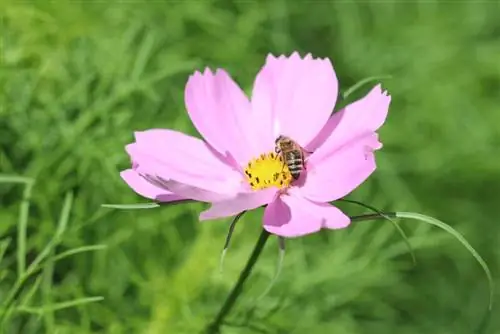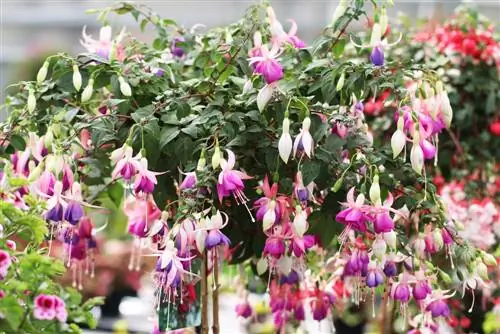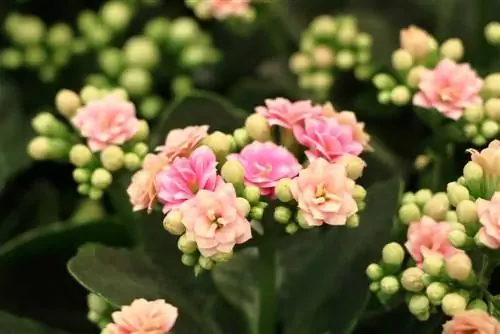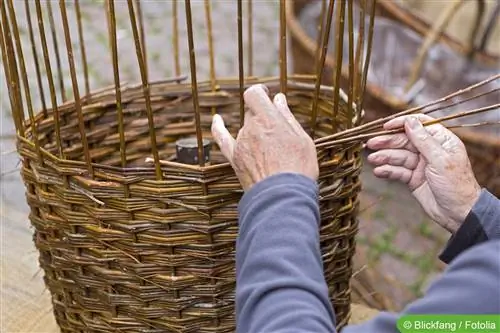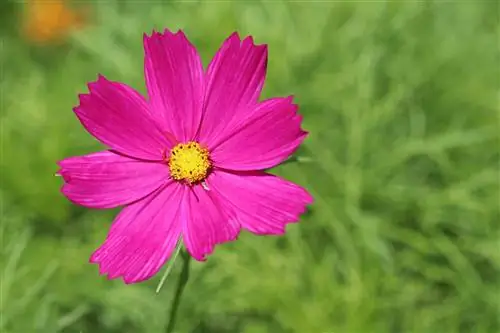- Author admin [email protected].
- Public 2023-12-17 03:39.
- Last modified 2025-06-01 06:48.
Cosmos bipinnatus has an upright, richly branched habit with heights of more than 80 cm. The elegant, dahlia-shaped flowers sit on delicate stems with finely structured foliage. The simple beauty earned it the name 'jewel basket'. Another special feature is the edibility of the flowers. They taste slightly sweet and decorate salads and desserts. Consequently, this perennial is non-toxic, making it the ideal garden flower, children and pets.
Profile
- Plant family: Asteraceae
- Botanical name: Cosmos bipinnatus
- German names: decorative basket, pinnate-leaved decorative flower, cosmos
- Growth: annual, perennial, herbaceous
- Growth height: 80 - 100 cm
- Flowering period: June/July to October
- Flowers: single, single or multi-colored, edible
- Foliage: light green, pinnate
- Lime compatibility: lime tolerant
- Toxicity: not poisonous
Location requirements
The jewelry basket wants to be as warm and sunny as possible, with at least four hours of sun per day. It should also be protected from wind and heavy rain. Flower production is generally lower in partially shaded locations. The Cosmea thrives in fully shady places, but only produces a few flowers, which are usually not as colorful.
Soil texture
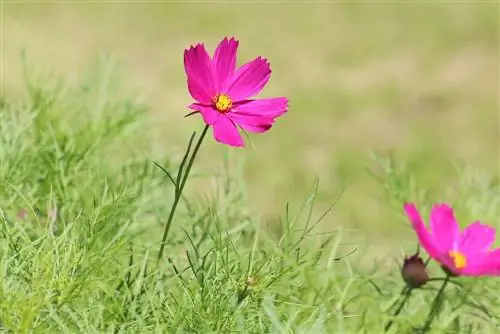
In general, cosmos grows in any good garden soil. It shouldn't be fertilized too much, otherwise it will mainly develop leaves and fewer flowers. If necessary, nutrient-rich soil can be thinned out a little by mixing in plenty of sand. A soil that is too heavy and dense can be improved by incorporating a generous portion of sand or gravel. Permeable, sandy and humus-rich soils with a moderate nutrient content are ideal. The pH value should be between 6.5 and 7.5. If the decorative basket is to be cultivated in a pot or balcony box, commercially available substrates for pot and house plants are suitable.
Preparing the planting
Cosmos bipinnatus is an annual garden flower. It is therefore advisable to grow them in pots on the windowsill and plant them in the garden from May onwards. If you prefer something a little more convenient, you can buy young plants in the garden center from May onwards.
- Before planting, get used to the changed conditions
- Cosmea is very sensitive to cold
- Is not hardy, dies in frost
- It's best to wait until the Ice Saints are over
- Put outside in a partially shaded and protected place for about two days
- If it's cold at night, it's better to bring it into the house
- In the following two weeks, gradually move further into the sun
- At the end of the second week, plant in its final place in the garden
- Prepare the floor accordingly
Tip:
Tip: When buying young plants, you should pay attention to he althy specimens. You can recognize them by their young, fresh green shoot tips and a well-developed root system.
Planting instructions
- First loosen the soil in the planting area thoroughly
- Soil should be fine, crumbly rather than too coarse
- Then remove all weeds, root residues and larger stones
- Depending on the nature of the soil, mix in some sand or compost
- Dig planting holes according to the number of cosmos to be planted
- Approximately one and a half times as deep and wide as the root ball
- Between the individual plants, maintain planting distances of 25 to 30 cm
- Insert the cosmos just as deep as before in the pot
- Finally, water carefully
- When watering, use a jug with a watering attachment if possible
Tip:
Due to the delicate stems of the decorative basket, it may be advisable to use appropriate supports when planting, especially with tall varieties.
Beautiful planting partners
Thanks to its naturalness, the decorative basket is a common sight, especially in natural and cottage gardens. It is versatile and easy to combine, be it in small groups of 3 to 5 plants, in flower borders and perennial beds, for example as a filler or background plant or in a flower box. It also looks good as a solitary perennial in larger planters. During the flowering period it can be easily combined with other Cosmea species and is a nice planting partner for phlox, delphiniums, dahlias and aster. This delicate perennial is also a real eye-catcher next to bluebells, coneflowers and various grasses.
Care instructions
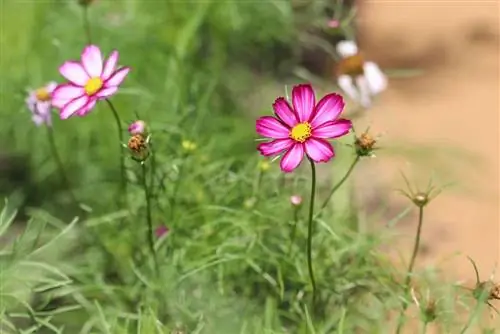
With the right care, you can enjoy your jewelry basket for longer.
Pouring
Cosmea is one of the undemanding flowers and requires little care. While young plants need a little more moisture, well-established specimens prefer a little drier and can even cope well with short-term drought. The natural amounts of rain are completely sufficient for them. However, it is advisable to water them occasionally in persistent drought and high temperatures.
The soil should not dry out completely. Plants in balcony boxes or pots, on the other hand, require regular watering. However, they cannot tolerate a permanently moist ball, neither in the pot nor in the bed. It is best to choose the morning or early evening hours for watering.
Tip:
Since the jewelry basket is insensitive to limescale, it can be watered with both rain and tap water.
Fertilize
The cosmos is a real survivor. Even if it appears rather delicate and fragile, when planted in the bed it usually needs no additional fertilizer. A soil that is too nutrient-rich would only promote growth and leaf formation. This in turn would result in the plants becoming top-heavy and therefore unstable, not to mention flower production, which would be severely impaired.
Tip:
If the decorative basket grows only sparsely and/or only produces a few flowers, this is often due to a location that is too dark and with too little sun. To remedy this, it is advisable to transplant to a sunnier place.
Cutting
Pruning, as is the case with other plants, is not necessary for the annual Cosmea. However, wilted flowers and other dead plant parts can be removed regularly. On the one hand, this has the advantage that the plant keeps forming new flowers and, on the other hand, it grows bushier and more branched.
Wintering
Due to the fact that the pinnate-leaved decorative flower only grows as an annual and is therefore not hardy, it makes no sense to overwinter it. This is not necessary because they sow themselves. If the plants die at the first frost, their seeds are frost-resistant and overwinter on the ground. Otherwise you can easily sow them by hand in the spring.
Propagate by sowing
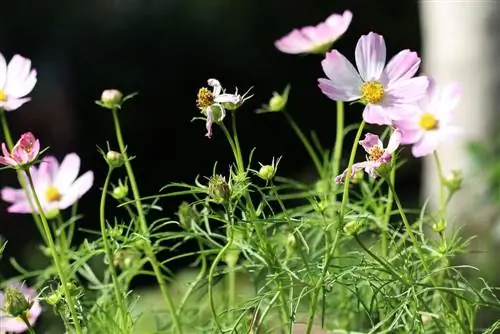
Cosmos bipinnatus can only be propagated by sowing. You can grow them on the windowsill or sow them directly in the garden, although pre-cultivation is usually the most effective. Pre-grown plants have a significant growth advantage over outdoor plants and bloom as early as April. The seeds can be collected from dead plants in autumn and stored in a cool, dry place until sowing.
They are found in the dry nuts, the so-called achenes. When collecting them, it is helpful to hold a container underneath them, as they fall off easily when touched. When it comes to self-harvested seeds, you should know that the young plants obtained from them usually do not bloom in the same colors as the mother plant. If you value a certain flower color, you have to buy the corresponding seeds from stores.
Advance
Pre-breeding is possible from around February/March. To do this you need small pots, a seed tray or a standard mini greenhouse and a suitable substrate. In the best case scenario, you use germ- and fungus-free seed or cactus soil.
- First fill the respective cultivation container with seed soil
- Then moisten the substrate
- Spread the seeds on top
- You can expect about 3-5 seeds in a 10 cm pot
- Cover the seeds thinly with soil
- Sowing depth should be a maximum of 1 cm
- Rub the soil between your hands and let it trickle over the seeds
- Keep constantly moist until germination
- Be sure to avoid substrates that are too wet
- Seedlings could be attacked by fungi and die
- Now cover the sowing container with translucent foil
- Make everything bright and warm
- In a place without direct sunlight
- Germination temperature ideally between 18 and 25 degrees
- Germination within 7-14 days
The young seedlings grow relatively quickly. As soon as they have developed more than one pair of leaves, they can first be separated into small pots and then transplanted to their final location in the garden after the ice saints. As already mentioned, it is best to give the decorative basket a short period of getting used to it before planting it in its final location in the garden.
Direct sowing
Between mid/late April and mid-May, direct sowing outdoors can be carried out, both in beds and in large pots or buckets. It is advisable to loosen the soil thoroughly before sowing. It is then moistened well and the seeds are distributed on it. When sowing directly in beds or containers, spacing of around 30 cm between seeds is recommended. You cover them thinly with fine, crumbly soil or sand, moisten the whole thing again and keep the substrate evenly moist until germination.
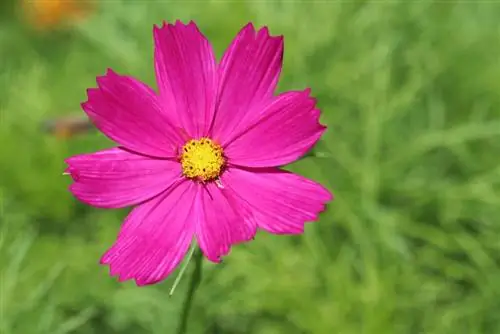
Watering should always be done using a watering attachment to prevent the seeds from being washed away. The seeds should not dry out until they germinate, even for a short time. Even if you watered them again, they would no longer germinate. This is because the seeds swell in the moist soil, which initiates germination. If this process is interrupted because the substrate dries out in the meantime, the seeds will no longer sprout because they will only swell once.
Diseases: Mildew
Diseases rarely occur with the pinnate-leaved decorative flower. Nevertheless, in warm and dry weather, mildew infestation can occur despite optimal care. Affected parts of the plant must first be removed. Mixtures of milk and water or baking soda and water as well as various plant broths for spraying can be used to combat it. As a preventative measure, you should avoid planting too densely and avoid mulching.
Pests
The jewelry basket is not only very popular with people. We show you how to properly protect it from pests.
Aphids
Aphids may occasionally appear. If there is an infestation, you can at least reduce it with a strong jet of water. Severely affected shoot tips should be cut off. Spraying with products containing rapeseed oil is also an option. In order to counteract future infestations, it is important to encourage the settlement of beneficial insects in the garden by creating nesting opportunities, for example in the form of insect hotels or lacewing boxes.
Snails
Snails, especially slugs, are a great danger to the cosmos. They primarily target the delicate leaves of young plants. This means that entire plants can fall victim to them. Slugs appear in persistently wet weather. To protect the plants, you can spread organic slug pellets during sprouting. Snail fences or snail collars can also be used.

